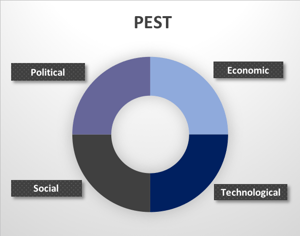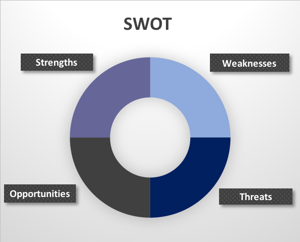Have you considered undertaking a comprehensive courthouse planning exercise to take a deep dive into external factors that may impact your court? Do you believe your court could benefit from a planning effort that sets a vision for the future? You may know you need a strategy to navigate through a changing environment but the best approach has not yet crystallized for you. Read on as we explore some strategic planning tools that can help guide your court more clearly into the future.
What is a PEST Analysis?
In a previous blog, I explored how a PEST analysis can be used to examine macro-environmental factors that may impact your court. PEST is a four-point framework that identifies factors outside the control of an organization – in this case, a judicial system. The following four categories of factors are explored in a PEST analysis:

By undertaking a PEST analysis, a court acknowledges that planning for future needs is a dynamic and fluid process. Changes in these factors can present both opportunities and threats for your court. Combining a PEST analysis with another type of strategic planning tool – a SWOT analysis – allows a court to delve into specific opportunities and threats associated which each factor identified during the PEST analysis.
What is a SWOT Analysis?
A SWOT analysis is a strategic planning tool that examines the following four factors that can be both internal and external to your court:

For our purposes, we will be focusing on opportunities and threats. Opportunities are favorable factors that provide an advantage to your court, such as the implementation of a new technology that decreases workload. Threats are factors that could cause harm to your court, such as budgetary constraints resulting in insufficient resources. Let’s take a look at some of the external factors that can impact a court’s operations and some opportunities and threats associated with each.
Political Factors
Political factors that can impact court planning fall into three general categories: changes in leadership, changes in legislation, and changes in industry regulation. Many of us who have spent our careers working in the judicial arena have witnessed firsthand the impact that political factors have on a court’s workload. A new leader takes office and sets a new agenda for enforcement and prosecutorial initiatives. A new law is passed that dramatically changes a court’s throughput, such as mandates to review sentences for convicted offenders. Getting ahead of the curve and identifying these potential factors, along with some likely opportunities and challenges associated with them, can better position your court to be flexible in an ever-changing political climate. Below is a look at some political factors that can impact a court, and some associated opportunities and threats.

Changing Political Factors
Economic Factors
Economic factors can also be tied to court workload. For example, areas that suffer from high poverty rates often experience high levels of crime. Court districts undergoing a shift from an agricultural-based to a professional services-based economy may experience an increase in civil cases against new businesses or an increase in bankruptcy filings as startups fail to take hold. Examining economic trends and projections in your court district could help you prepare for the potential impacts on court workload in the future. Below are some specific examples of economic factors that can affect a court district, along with the related opportunities and threats.

Changing Economic Factors
Social Factors
Social scientists have long correlated changing social factors with changes in crime rates, which directly impact court workload and operations. It is important to analyze historical and projected population trends, including population growth or decline, age and gender distribution, and immigration patterns within a community. For instance, a growing number of males in their teens and 20s is frequently tied to a growth in crime. An aging population is more often associated with growth in civil cases, related to wills, mental health matters, guardianships, financial exploitation, and claims regarding eligibility for government services. Below is a look at some social factors that can affect a court, and some corresponding opportunities and threats.

Changing Social Factors
Technological Factors
We live in a digital age where technology is rapidly changing and is having a tremendous impact on how government and private industries conduct business. Courts are no exception. While the end result of new technologies can be efficiencies for a court, there may be growing pains along the way. A court will be required to adequately train staff and possibly even the legal community and the public so that all users of new technologies are up to speed. The advent of new technologies may also dramatically change the space needs within a courthouse. Let’s explore some of the technological factors that could impact court operations and some opportunities and threats associated with each.

Changing Technological Factors
Is it Time for a Strategic Planning Effort for Your Court?
A strategic planning effort that closely examines both the opportunities and threats associated with changing variables in your court district can be key to preparing your court for the future. You may find it helpful to engage the services of a court consulting firm to walk you through the strategic planning process on a more detailed level. While no one can predict with certainty what the future will hold, using strategic planning tools to develop a plan for your court could help you get ahead of the curve.




.jpg)
.jpg)
.jpg)
.jpg)
.jpg)
-1.jpg)
.jpg)
.jpg)

